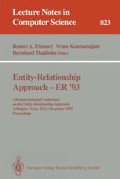Abstract
A tool for conceptual design is introduced which transforms requirement specifications in natural language into concepts of the EER model. The transformation is based on the assumption that the meaning of data modeling concepts can be derived from structures of natural language. A parsing algorithm which accesses information of a grammar and a lexicon is designed to meet the requirements of the tool. The parsing results are processed further on by rules and heuristics which set up a relationship between linguistic and design knowledge. The design tool works interactively to handle information which is ambigous, incomplete or redundant.
Preview
Unable to display preview. Download preview PDF.
References
J. Allen; Natural Language Understanding; Benjamin/Cummings, Menlo Park, CA, 1987
V. De Antonellis, B. Demo; Requirements Collection and Analysis; In [11]
P. Atzeni, C. Batini, M. Lenzerini; INCOD: A System for Coceptual Design of Data and Transactions in the Entity-Relationship Model; In: Entity-Relationship Approach to Information Modeling and Analysis, pp. 375–410, P.P. Chen (ed.), Elsevier Science Publishers B.V. (North-Holland), ER Institute, 1983.
B. Barnett, H. Lehmann, M. Zöppritz; A Word Database for Natural Language Processing; Proc. 11th Int. Conf. COLING, pp. 435–40, Bonn August 1986
C. Batini, S. Ceri, S. Navathe; Conceptual Database Design, Entity Relationship Approach; Benjamin/Cunnings Publ. Company 1992
G. Bono, P. Ficorilli; Natural Language Restatement of Queries Expressed in a Graphical Language; 11th Int. Conf. on ERA, Karlsruhe, Germany, October 1992
M. Bouzeghoub, G. Gardarin, E. Metais; Database Design Tools: An Expert System Approach; in Proc. Int. Conf. VLDB, pp. 82–95, Stockholm, Aug. 1985
G. Bracchi, S. Ceri, G. Pelagatti; A Set of Integrated Tools for the Conceptual Design of Database Schemas and Transactions; In [11]
S. Ceri; Methodology and Tools for Data Base Design; North Holland Publishing Company 1983.
P.P. Chen; English Sentence Structure and Entity Relationship Diagrams; In: Information Sciences 29 (2), pp. 127–149, 1983.
J. Choobineh, M. Mannino, J. Nunamaker, B. Konsynski; An Expert Database Design System Based on Analysis of Forms; IEEE Transactions on Software Engineering, pp. 242–253, Vol. 14, No. 1, Feb. 1988
M. Colombetti, G. Guida, M. Solvico; NLDA: A Natural Language Reasoning System for the Analysis of Data Base Requirements; In [11]
Ch. F. Eick; From Natural Language Requirements to Good Data Base Definitions — A Data Base Design Methodology; In Proc. Int. Conf. on Data Engineering, pp. 324–331, IEEE, Los Angeles, CA, USA, 24.–27.4. 1984
Ch. F. Eick, P. Lockemann; Acquisition of terminological knowledge using database design techniques; In Proc. ACM SIGMOD Conf.; AUSTIN, TX, May 1985
G. Görz; Strukturanalyse natürlicher Sprache; Addison-Wesley, Bonn, 1988
S. Lanka; Automatically Inferring Database Schemas; Proc. 9th IJCAI-85, Vol.1, pp. 647–649, August 1985.
S. Sabbagh; SESAME: An Application of Entity Relationship Models to a Natural Language User Interface; In: Proc. 9th Int. Conf. ERA, Lausanne; Oct. 1990
H. Shimazu, S. Arita, Y. Takashima; Design Tool Combining Keyword Analyzer and Case-based Parser for Developing Natural Language Database Interfaces; Proc. 15th Int. Conf. COLING, Vol. II, pp. 735–741, Nantes, August 1992
J. F. Sowa; Logical Structures in the Lexicon; Knowledge Based System, Vol.5, No.3, pp. 173–182, Sept. 1992
B. Tauzovich; An Expert System for Conceptual Data Modelling; Proc. 8th Int. Conf. on ERA, pp. 205–220, Toronto, Canada, October 1989
T. J. Teorey, D. Yang, J. P. Fry; A Logical Design Methodology for Relational Databases Using the Extended Entity-Relationship Model; ACM Comput. Surveys 18 (2), pp. 197–222, 1986
V. P. Tseng, M. V. Mannino; A Method for Database Requirements Collection; Journal of Management Information Systems, Vol. 6, No.2, Fall 1989
F. S. Tseng, A. L. Chen, W. P. Yang; On Mapping Natural Language Constructs into Relational Algebra through E-R Representations; Data & Knowledge Engineering 9, pp. 97–118, North Holland, 1992/93
Author information
Authors and Affiliations
Editor information
Rights and permissions
Copyright information
© 1994 Springer-Verlag Berlin Heidelberg
About this paper
Cite this paper
Tjoa, A.M., Berger, L. (1994). Transformation of requirement specifications expressed in natural language into an EER model. In: Elmasri, R.A., Kouramajian, V., Thalheim, B. (eds) Entity-Relationship Approach — ER '93. ER 1993. Lecture Notes in Computer Science, vol 823. Springer, Berlin, Heidelberg. https://doi.org/10.1007/BFb0024368
Download citation
DOI: https://doi.org/10.1007/BFb0024368
Published:
Publisher Name: Springer, Berlin, Heidelberg
Print ISBN: 978-3-540-58217-5
Online ISBN: 978-3-540-48575-9
eBook Packages: Springer Book Archive

